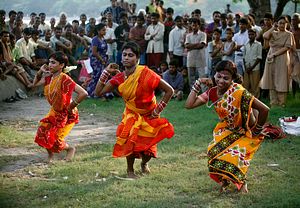They are a feature of traditional ceremonies in the feudal heartlands of Uttar Pradesh (UP) and Bihar: young boys who dress as women and dance at weddings and other auspicious occasions. These young male performers, known as launda dancers, are vulnerable to organized patterns of exploitation that include prostitution, violence, sexual assault and sexually transmitted infections.
Whereas launda dancers were once hired by poorer families who could not afford the higher fees for female dancers, today the employment of launda dancers is popular across all spectrums of society within UP and Bihar. Young boys, mostly from poorer backgrounds in West Bengal, migrate to UP and Bihar during the spring and winter wedding seasons and are contracted by wedding orchestras to work for several months at a time. Financial and sexual exploitation by the hiring wedding bands has become synonymous with the tradition of launda dancing, with many of the boys forced into prostitution.
A UNICEF report estimates that 70 percent of dancers enter the profession as children, often far removed from the protection of families. During the wedding ceremony launda dancers are a focal point, leading the groom’s entourage to the bride’s home. The boys are exposed to the decadence of a largely male audience, often forced to perform late into the night as the singing and dancing of the occasion become more suggestive.
A range of physical and sexual abuse towards launda dancers has been documented during wedding processions. These include: being bitten, burned with cigarettes, assaulted and gang raped at knifepoint, with even reports of deaths for protesting against such abuses. In an example of the extreme violence launda dancers are susceptible to, boys have described being mutilated with blades before being raped.
The thousands of boys who migrate to work during the wedding seasons are often caught between the politics of their gender identity and widespread poverty. Young boys deemed to have an effeminate demeanor are stigmatized and ostracized from mainstream social roles. In a study conducted by the Kolkata-based NGO People Like Us (PLUS), almost half the boys interviewed described their first sexual encounter occurring between the ages of 9-12 years, with almost 90 percent of these encounters identified as forced. The report comments that, “these boys are at an age when the costs of migration and prostitution are not completely comprehended but the visible benefits are observed. This makes them extremely vulnerable to being attracted to the proposition of supporting the family through prostitution and unsafe migration.”
Cultural restraints in sections of Indian public discourse often deny the existence of male sexual abuse and forced male prostitution, tacitly sanctioning the highly criminal environments that many launda dancers become susceptible to. Prevailing gender stereotypes contribute not only to the limited social space in which launda dancers are able to express their identity, but also reinforce gender norms that enable the use of sexual exploitation and violence. The sexual and gender identity of the “effeminate” launda dancer contrasts with that of the “organic” social male, resulting in the occluded, but culturally condoned, sexual regulation of “other” men by “real” men.
The limited social role for launda dancers also carries a significant health burden. Whilst some choose to return home following the wedding seasons, others remain mired in a world of sexual subservience and bonded labour. Physical mobility, multiple partners and unsafe sexual practices significantly increase the risk of contracting sexually transmitted infections and HIV. The marginalized bodies of launda dancers become further brutalized through forced sexual predation, with limited access to sexual health education and appropriate medical treatment.
With much recent attention in India understandably focusing on sexual abuse towards women, the forced prostitution and exploitation of young boys receives little attention. Rooted gender roles identifying males as inherently more capable of self-protection and recovery has masked the social abuse of young launda dancers.
The taboo embedded in narratives of male-on-male sexual violence has prevented open challenges to this custom in traditional settings. Indeed, the ability of the Indian state to even counter the multiple factors that have made launda dancers part of an established and rooted practice is questionable. Before it can challenge such practices, it must first challenge its own prejudices. The task to alleviate the often untold suffering of the launda dancers falls, therefore, not just on the state but also the citizens who can help to shape public discourse and define the boundaries of social acceptability.
Ahmed Wakas Khan is a freelance journalist based in England and World Editor at The Platform. He can be followed @SireAhmed

































